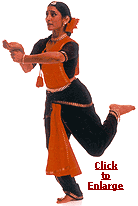|
About Rajika Ongoing Projects Indian Dance & Theatre Lamp Pose Improvising Dance to Music Flamenco Natyam Bharatanatyam Variations The Western Stage Writings & Lectures Contact Home |
|
|
|
Traditionally, Indian theatre incorporates music and dance. In most forms of Indian classical dance - such as Bharata Natyam, Odissi, and Kuchipudi - the performer is actor and musician, as well as dancer.  While learning the basic steps of a dance form a student also learns to make rhythms with the feet, - which rhythms can be expressed in spoken syllables like taka dhimi. Eyes, neck, shoulders, and hands are also used to accentuate rhythm and, later, to embellish melody. More advanced training involves learning hand gestures and a stylised technique of mime with which to elaborate on the meaning of poetry that may be sung or chanted. During a performance, texts are interpreted, and meanings - philosophical or otherwise - are explored. An accomplished dancer used to be expected to improvise movements during performance, following insights that came from the music, and the moment. Today, as dance and theatre forms develop on the modern stage, and two or more dancers perform what was intended as a solo form, danced movements are usually set before-hand. The music for dance, too, is set, with musicians often told how many times to repeat a line of verse or melodic phrase. In her current work Rajika Puri explores new relationships between music and movement. Inspired by the wonderful singing of acclaimed vocalist of Carnatic music, Aruna Sairam, she explores ways of following Aruna's music as it is improvised in performance. She aims to add a visual dimension to the music and complement it, in acknowledgement of the primary role it plays in Indian performing arts, rather than to subordinate the music to the dance. Bharata Natyam developed in the temples of Tamilnadu in south India, performed by devadasis - women dedicated to rituals in honour of the presiding deity. The name was given to it in the 1930's, when it was acknowledged as a classical art that followed the precepts of Bharata's Natya Shastra, the 2nd C. Sanskrit treatise on Indian theatre, which had then only recently been re-discovered. Much of the typical repertoire - like the alaripu, jatiswaram, varnam - on which contemporary compositions are based, was conceived of by four great maestros known as The Tanjore Quartet, in the early nineteenth century. Their male descendants, who taught and conducted the music but never danced, were the gurus of most current exponents of the art, many of whom now become` teachers themselves. The music which accompanies Bharata Natyam belongs to the Carnatic or south Indian school, and the dancer's rhythms are complemented by a two headed drum, mridangam. The songs to which it is performed, even when dealing with romantic themes, are usually addressed to Hindu deities, with a special place given to Shiva as Nataraja, Lord of Dance. Lyrics are in several south Indian languages - Tamil, Telegu, Kannada - and Sanskrit. Odissi is the dance of the maharis - women dedicated to singing and dancing for Lord Jagannath (a local form of the deity Krishna) in his great temple at Puri, in Orissa. It's revival, with the help of the few maharis left, and teachers of gotipuas (boy dancers who performed outside the temple, dressed as girls) dates to the 1950's. The Odissi repertoire - such as mangala charan, pallavi, and sthayee nrtta - is attributed to Oriya scholars working with a handful of gurus (teachers), like Deba Prasad Das, Kelucharan Mahapatra, and Pankaj Charan Das, who virtually recreated the form after studying medieval temple sculpture, palm-leaf manuscripts, and even local folk dances. Odissi music draws its inspiration from Oriya folk music, and many Carnatic ragas sung in a north Indian manner. It is accompanied by a two-headed drum, pakhawaj, precursor to the tabla. A favoured text is Jayadeva's 12th C. love poem, Gita Govinda ("Song of Krishna") written in Sanskrit, though Odiya folk songs on similar themes, and compositions dedicated to other deities are also danced. |
Copyright © 2000-2013 Rajika Puri